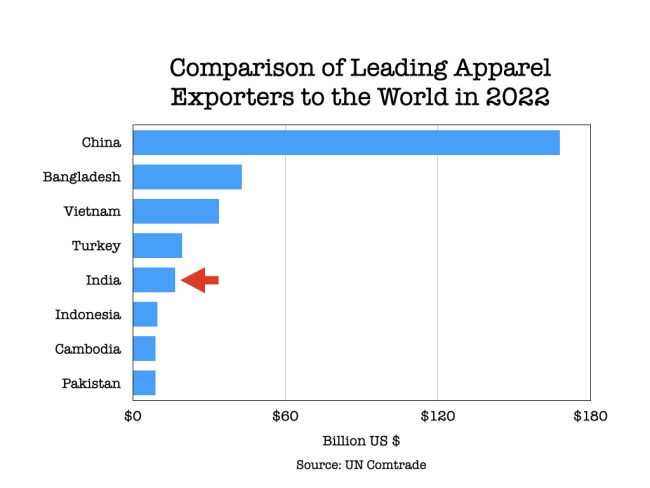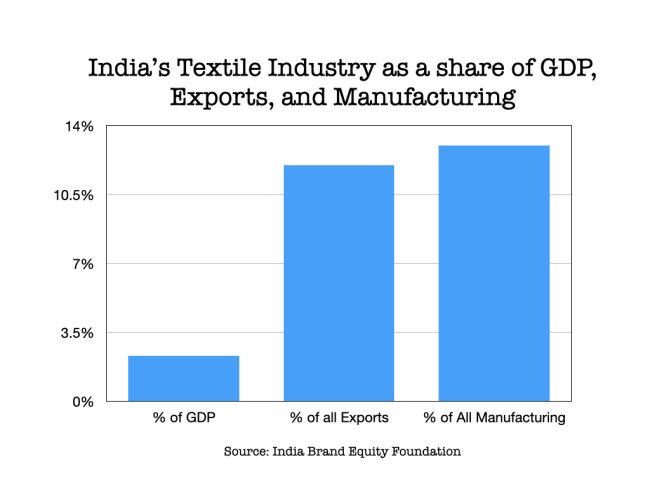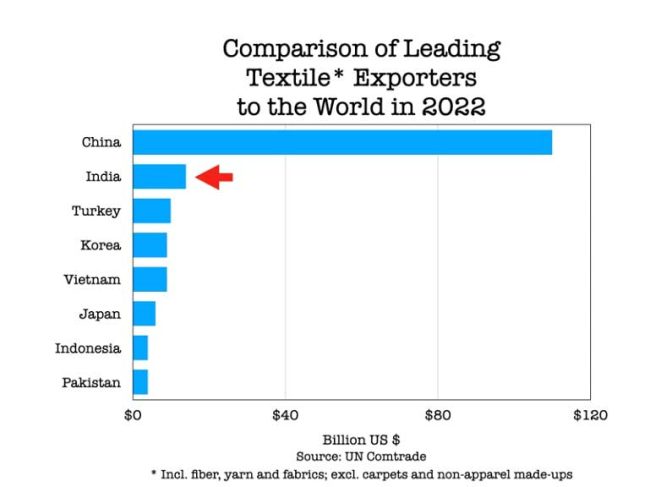
What’s next for India’s textile and apparel industry?
The industry’s success will be influenced by factors such as technological disruptions, changing consumer preferences, and geopolitical dynamics, informs Robert P Antoshak.
The success of India’s textile and apparel industry is multifaceted, reflecting a blend of historical legacy, economic impact, technological advancements, global competitiveness, and adaptability to changing market dynamics. There is much to discuss when considering the various aspects of the industry’s success while providing insights into its economic contributions, technological evolution, global standing, government initiatives, and future prospects.
At the outset, it is essential to highlight India’s overwhelming reliance upon cotton for most of its textile products. The uptake of synthetic fibres by India’s textile industry contrasts with the experience in China. Of course, China boasts a competing cotton industry, but textile mills embraced synthetic fibres from an earlier stage of development.
In fact, China is the world’s largest producer of synthetic fibres and textiles — and cotton textiles. The challenge for India will be balancing its cotton production while bolstering the development of a vibrant synthetic fibre sector, learning from China’s experience.
Another point to consider is India’s overall textile and apparel complex develops centres of India’s slow progress in the cut-and-sew industry. Although growing, this sector needs to catch up to competitors elsewhere in the region — most notably, Bangladesh.
True, Bangladesh lacks a textile industry of the scale offered by India. Still, as global sourcing of apparel shifts away from China to countries like Vietnam and Bangladesh, India will lose out on opportunities in the cut-and-sew space. Indeed, lost opportunities represent a not-insurmountable challenge for India as it is currently configured. However, it remains a challenge nonetheless — a hill to climb (see Figure 1).

Figure 1: Comparison of leading apparel exporters to the world in 2022 (in billion US $).
Economic contributions
The economic significance of India’s textile industry cannot be overstated. This sector contributes substantially to the country’s GDP (see Figure 2), employment, and export earnings. The industry’s success is evident in its role as a significant employer, providing livelihoods to millions, both in urban centres and rural areas where traditional handloom practices persist.

Figure 2: India’s textile industry as a share of GDP, exports, and manufacturing
India is a global leader in textile exports, leveraging its diverse range of fabrics, including traditional handwoven textiles and modern, mass-produced materials (see Figure 3). The textile and apparel sectors collectively form a crucial component of India’s economy, fostering entrepreneurship, innovation, and economic development.

Figure 3: Comparison of leading textile* exporters to the world in 2022 (in billion US $)
Technological advancements
The evolution of India’s textile and apparel industry is intertwined with technological advancements. The sector has embraced modern manufacturing practices in the post-independence era, emphasising large-scale mills. However, over the last 30 years or so, a notable shift towards technology adoption has occurred.
Automation, computer-aided design, and advanced machinery revolutionised production processes, enhancing efficiency, reducing costs, and elevating the quality and precision of textiles and garments produced. The industry’s ability to integrate technology seamlessly into its operations is a testament to its adaptability and commitment to staying competitive in the global market.
Additionally, Indian mills have made significant inroads into the technical textiles market, a development that may spur more production of synthetic fibers and the adoption of advanced manufacturing programs.
Global competitiveness
India’s textile and apparel industry has emerged as a global player, competing successfully on the international stage. The country is a preferred sourcing destination for many international apparel brands and retailers. The ability to produce a diverse range of textiles at competitive prices and adherence to quality standards has positioned India as a reliable and sought-after global supplier.
Nevertheless, success in global competitiveness is not only driven by cost-effective production but also by the industry’s ability to meet the dynamic fashion preferences of consumers worldwide. India’s adaptability to changing trends and consumer demands has played a pivotal role in sustaining its global standing.
Government initiatives and policy support
The Indian government has played a crucial role in supporting and nurturing the textile and apparel industry. Various initiatives and policies have been introduced to address challenges, promote growth, and enhance competitiveness. For instance, the Technology Upgradation Fund Scheme (TUFS) is one such initiative to modernise manufacturing infrastructure.
Textile and apparel parks have been established to encourage the clustering of production units, providing necessary infrastructure support and streamlining processes. These government interventions have contributed to the industry’s success by creating an environment conducive to growth and development.
Fashion and retail dynamics
The growth of the fashion and retail sectors in India has profoundly impacted the textile and apparel industry. The emergence of domestic and international fashion brands has increased consumer demand for trendy and affordable clothing. The industry’s success is reflected in its ability to cater to diverse consumer segments, from traditional handwoven textiles to contemporary, fast-fashion offerings.
E-commerce platforms have further revolutionised retail, providing consumers easy access to a wide range of apparel. The industry has adapted to the online retail model, showcasing its agility and responsiveness to changing consumer behavior.
Sustainability initiatives
As we all know, there has been a growing emphasis on sustainability within the global textile and apparel industry in recent years. India has not been left behind in this trend. Many Indian manufacturers have adopted eco-friendly practices, sustainable materials sourcing, and ethical production methods.
This shift towards sustainability aligns India’s textile industry with global expectations and positions it as a responsible player in the international market. Moreover, the success of sustainability initiatives goes beyond meeting consumer expectations; it also addresses environmental concerns and ensures the industry’s long-term viability. This proactive approach to sustainability enhances the industry’s reputation and opens new avenues for market growth.
Further, as India expands its cut-and-sew capabilities, sustainability will only play a more significant role in sourcing and manufacturing decisions with far-reaching future implications for India’s industry. But, as energy consumption statistics document, India, along with its major textile and apparel-producing competitors, relies far more on traditional fossil fuels to power its factories, less so on renewable energy sources (see Table 1).
Challenges and future prospects
Despite the success and resilience of India’s textile and apparel industry, it faces ongoing challenges. Global economic uncertainties, fluctuations in raw material prices, and competition from other manufacturing hubs are persistent challenges. The sector must navigate these challenges while simultaneously innovating and adapting to emerging trends.
Looking to the future, the industry’s success will be influenced by factors such as technological disruptions, changing consumer preferences, and geopolitical dynamics. Investments in research and development, skill enhancement, and strategic collaborations will be crucial for sustaining and enhancing its global competitiveness.
The success of India’s textile and apparel industry is rooted in its rich legacy as a quality maker of textiles, economic contributions, technological advancements, global competitiveness, government support, and adaptability to evolving market dynamics. As the industry continues to navigate challenges and embrace opportunities, it remains a crucial driver of economic growth, employment generation, and global trade for the nation.
About the author:

Robert P Antoshak is a Partner at Gherzi Textil Organisation. He is also a consultant to the Global fibre, textile and apparel industries.




